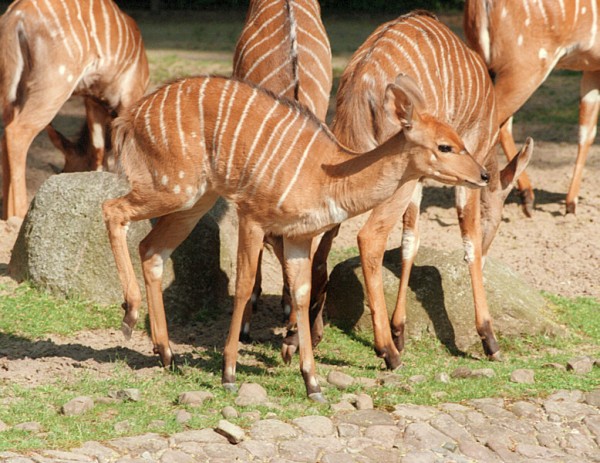Nyala

Nyala,
Tragelaphus angasii
Photographer: Paul Bolstad,
http://www.forestryimages.org/
Genus Tragelaphus
Mountain
nyala, Tragelaphus buxtoni
Gray Nyala, Tragelaphus angasii
The Nyala, Nyala angasii, is a Southern African antelope.
It is a spiral-horned dense-forest antelope that is uncomfortable
in open spaces and is most often seen at water holes.
Nyalas live alone or in small family groups of up to 10 individuals.
The male stands up to 120 cm , the female is up to 90 cm tall. Length
of tail is 40-55 cm. Weigth 55-140 kilos.
The male has loosely spiraled horns and a long fringe on throat
and underparts; the female has no horns and no
noticeable fringe. The male is dark brown, white on the face and
neck, with vertical white stripes on the body.
The female is reddish brown with white vertical striping.

Male
nyala, Tragelaphus angasii, Kruger National Park, South Africa.
Date July 2002
Source: http://images.nbii.gov/details.php?id=53467&cat=Mammals
(terminated Jan.2012)
The rare Mountain Nyala, Tragelaphus buxtoni, is limited to central
Ethiopia. While superficially similar to the lowland Nyala,
it is now considered more closely related to the kudu.
The name "Nyala" is the Swahili name for this antelope,
which itself comes from the Zulu "Inyala".
The Latin name comes from "tragos" (he-goat), "elaphos"
(deer), and George French Angas of South Australia.[1]

Nyala
http://www.schmode.net/nyala001.htm
(not active
as per Sept.2010)
The
two sexes are looking entirely different. Both sexes have a white
chevron between the eyes, and the bushy tail is white
on the underside. The short-haired, rufous-chestnut coat of females
and immature males has 10 or more vertical white stripes
on the sides. There are white spots on the face, throat, flanks,
and thighs.
There are no horns on females, and there is no mane on the neck.
The males are larger than females, and have a shaggy dark
brown to charcoal grey coat, often with a bluish tinge. The length
of this coat generally obscures the torso stripes.
There are fewer and less conspicuous markings than on the female,
but there is a bold erectile white dorsal crest.
The lower legs are tawny. The yellow-tipped horns have 1-1.5 twists,
and grow 60-83 cm..[2]

Tragelaphus
angasi
http://www.schmode.net (not
active as per Sept.2010)
While Nayla have been severely depleted in the past, total population
numbers have been estimated at ca. 32,000,
with over 80% in protected areas and 10-15% on private land. Population
trends are generally stable or increasing.
It therefore does not currently meet the criteria for threatened
status or for Near Threatened.
As long as effective
protection and management are maintained in the key protected areas
for this species and its numbers
continue to increase on private land, its status is unlikely to
change. Its long-term survival will be further enhanced if the
current efforts
to rehabilitate the wildlife of areas such as Gorongosa, Banhine
and Zinave National Parks,
Gaza Province and the Maputo reserve in Mozambique are successful.
[3]

Tragelaphus
angasi
http://www.schmode.net (not
active as per Sept.2010)
The Nyala's natural range comprises south-eastern Africa
from the Lower Shire Valley in Malawi through Mozambique
and Zimbabwe to eastern South Africa and Swaziland. It has been
introduced to Namibia on private land in the northern
commercial farming districts. Likewise it does not occur naturally
in Botswana, but some of the Tuli block farms in the
east have been colonised as a result of the spread of Nyala from
populations introduced to farms in the adjacent
region of South Africa
In Swaziland, the species was extinct by the 1950s, but they have
been successfully reintroduced. [3]
An inhabitant of dense thickets, forest, and open-thicket woodland
mosaic, generally near water. Nyala feed selectively on
both the leaves and fruits of woody plants as well as grasses; although
they drink daily where water is available, in parts of
their range in Mozambique and Zimbabwe they are found where no surface
water is present for several months of the year.[3]
References:
[1] http://en.wikipedia.org/wiki/Nyala
[2] http://www.ultimateungulate.com/artiodactyla/Tragelaphus_angasii.html
[3] IUCN SSC Antelope Specialist Group 2008. Tragelaphus angasii.
In: IUCN 2011. IUCN Red List of Threatened Species. Version
2011.2. <www.iucnredlist.org>. Downloaded on 30 January
2012. |












